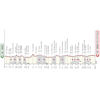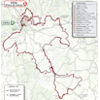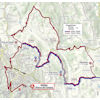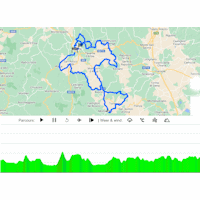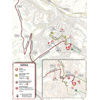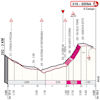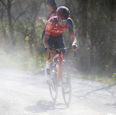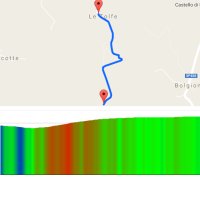The first sterrato appears as early as kilometre 14. It’s a solid way to get warmed up to all the hardship ahead. ‘Vidritta’ is 2.1 kilometres long, virtually flat, and perfectly straight.
Sector 2 presents a more accurate taste of what the Strade Bianche is all about. It’s 5.8 kilometres long and occasionaly kicking up to 10%. Following two virtually flat sterrati – respectively 4.4 and 5.5 kilometres – the first climb on tarmac appears, leading up to the fortified town of Montalcino.
On to sterrato 5 and in its wake sector 6. An enchanting dust road in itself, with fields and forest left and right, sterrato 5 is – at 11.9 kilometres – the longest sector of the day. Hardly time for a breather, as there is merely 1 kilometre on tarmac before sector 6 appears. ‘Pieve a Salti’ is 8 kilometres long and bike handlings skills are needed. It meanders on winding roads through the Tuscan countryside and alternates between climbing and descending.
Sector 7 makes an entrance after roughly 11 kilometres on smooth asphalt. It’s the first sterrato with five stars, running almost entirely uphill for 9.5 kilometres. The last part is the most trying bit, as ‘San Martino in Grania’ ends with a twisting climb before meeting the tarmac again.
Another 5 starred sterrato begins at kilometre 131. At 11.5 kilometres, sector 8 is arguably the toughest of all sterrati. Most of the gravel points uphill, but the strip features some tricky descents as well. In 2022, Tadej Pogacar launched a solo attack in this phase of the race, only to be seen again in Siena – although the race was 30 kilometres shorter then.
Following a lumpy intermezzo on asphalt – which may sound better than it actually is, as most riders will be hanging on the ropes by now – four sectors within 15 kilometres are expected to open the endgame. It begins with the shortest sterrato of the day, just 600 metres but pepped up with a brutal ramp before hitting the tarmac again in Vico d’Arbia. Moments later the 2.4 kilometres long ‘Strade di Colle Pinzuto’ will weary the legs still further. A 15% ramp welcomes the pilots and hairpins are easing the gradients while climbing, but simultaneosly causing loose gravel.
The illustrious Le Tolfe strip used to be the last sterrato of the Strade Bianche, but it now precedes an extra lap of 30 kilometres. Bike handling skills are essential, as the 1.1 kilometres sector opens with a short descent and closes with 18% gradients. The riders then continue onto a new sector, the 1.3 kilometres long ‘Strada del Castagno’.
After 14 kilometres with some challenging passes on tarmac sector 13 is a relatively easy section of 3.3 kilometres. It leads back to Vico d’Arbia and then the riders re-enter the ‘Strade di Colle Pinzuto’ with its 15% ramp at the bottom before it keeps climbing gradually all the way until the summit.
And on we go to the second toil up to Le Tolfe, this time the final sterrato with its tricky mix of a short drop and insane uphill gradients. There are 12 kilometres remaining when the riders pass the hilltop chapel in the village. The winding road on the run-in to Siena favours attackers, as chasers will have difficulty pinpointing them.
With 5 kilometres remaining the road goes downhill, only to go vertical again – quite literally – in the last kilometre. Entering the city walls of Siena, a 16% sector on rough stone slabs welcomes the riders. The Via Santa Caterina climb is 500 metres long and averages 12%, before a right turn onto flat roads precedes a left and another right turn onto the Piazza del Campo, Siena’s iconic square resembling a theatre.
Ride the route yourself? Download GPX Strade Bianche 2024.
Other interesting reads: race results/report and start list 2024 Strade Bianche.
Strade Bianche 2024: routes, profiles, more
Click on the images to zoom
